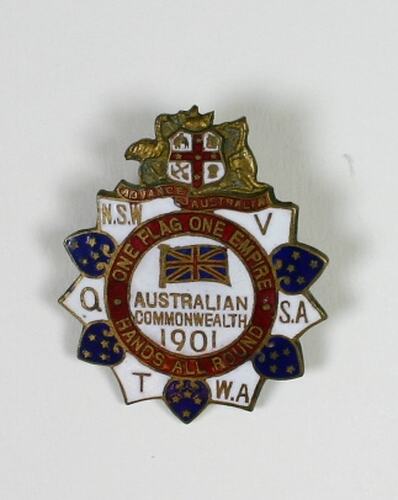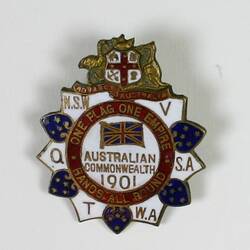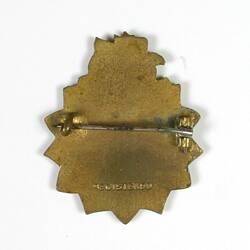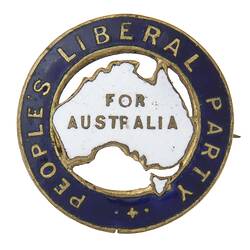Summary
Alternative Name(s): Brooch; Medal on Brooch Mount
Badge consisting of gilt bronze and enamel medal on brooch mount. Would have been worn by a supporter of Federation. Although the Commonwealth of Australia Constitution Act had passed both houses of the British Parliament, it was not certain that all six colonies would join the Federation. Each colonial Parliament had to pass legislation agreeing to become part of the Commonwealth, and then hold referenda. In 1899 referenda were held in Victoria, New South Wales, Tasmania, South Australia and Queensland. Western Australia held a referendum in 1900.
Around the time of Federation, iconography representing the federated states was popular on a range of media, including badges, medals, invitations, books and programs. This example includes an awkwardly-expressed abbreviation for each state, the Advance Australia arms, and the motto 'One Flag One Empire' on a white background that recalls the oft-used white Australia motif.
'One King, One Flag, One Empire, One Fleet' was the motto of the Empire Day movement which from 1905 in Australia had annual celebrations on May 24th. The rationale of the Empire Day movement was described in an early 20th century school book as 'An effort throughout the King-Emperor's dominions to remind all British subjects of the virtues which make a good citizen, such as loyalty, patriotism, courage, endurance, respect for, and obedience to, lawful authority, and to encourage self-sacrifice for the public good; to teach all, and especially the young, the sacredness of the trust committed to them; and to inspire them with determination to do their duty.'
The newly federated Australian government quickly introduced national legislation to protect its security and assert its sense of identity as a member of the British Empire. In a rare reference to First Peoples in the new constitution, section 127 states that 'in reckoning the numbers of peoples of the commonwealth, or of a State or other part of the Commonwealth, aboriginal natives shall not be counted.' And in contrast to the rest of the population, the making of laws relating to First Peoples is left solely in the hands of the states.
One of the first acts passed was the Immigration Restriction Act - known as the White Australia policy. The Immigration Restriction Act restricted the entry of non-Europeans by means of a dictation test, which could be given in languages other than English. People suffering physical or mental diseases, convicted criminals, prostitutes and those reliant on charity, were also refused entry. From 1901 the Australian Government passed other legislation which marked out the racial boundaries of the nation. The Pacific Islands Labourers Act, 1901, enabled the deportation of over 9,000 Pacific Islander labourers who had been working in the sugar cane fields of Queensland and northern New South Wales. In 1903, the Commonwealth Naturalisation Act excluded all non-Europeans from becoming naturalised, and severely restricted their ability to bring spouses and children to Australia.
The ideal of the white, egalitarian Australian became increasingly widespread around the time of Federation. Publications such as the Bulletin, and organisations such as the Australian Natives' Association, fostered this identity, contrasting it with Great Britain's 'old world', class-based society. Yet Australian nationalism and loyalty to the Empire went hand-in-hand. Australia's involvement in World War I helped strengthen national pride. At the same time First Peoples were being omitted from definitions of national identity and citizenship. Ideas about racial superiority dominated the development of policy. Unions had long argued against the influx of immigrant workers, particularly Chinese, fearing an erosion of jobs and pay. The Labor Party won control of the House of Representatives in 1910 after an election run on an explicitly racist platform. Prime Minister Edmund Barton stated in 1902 that 'We can bring in, without delay, our kinsmen from Britain and, if the numbers be insufficient, such other white races as will assimilate with our own. Or we can.see the doors of our house forced, and streams of people from the lands where there is hardly standing room pour in and submerge us.'
The Australian Natives' Association was established in Melbourne in 1871 as a non-partisan and non-sectarian friendly society for Australian-born, white men seeking to shape Australia's nationhood and identity. The ANA was a strong advocate for Federation and became an advocate for White Australia. It was a staunch supporter of trade protection and immigration restriction, and Prime Minister Alfred Deakin was a member
Physical Description
Bronze gilded and enamelled medal on brooch mount. Star-shaped medal with Australian coat of arms at top. British flag at centre, in red, white and gold, against white background; inscription below. Inscribed red circle outside this. On outer edge the white background has initials of Australian states on each point, interspersed by heart-shaped leaf in blue with gold stars.
More Information
-
Collecting Areas
-
Acquisition Information
Purchase
-
Date Issued
-
Place & Date Used
-
Inscriptions
INSCRIPTIONS: At top: 'ADVANCE AUSTRALIA'. Clockwise around edge on white background: 'N.S.W / V / S.A / W.A / T / Q'. On red circle within: 'ONE FLAG ONE EMPIRE / HANDS ALL ROUND'. At centre, beneath flag: 'AUSTRALIAN COMMONWEALTH 1901'. On reverse: 'REGISTERED'.
-
Classification
-
Category
-
Discipline
-
Type of item
-
Object Measurements
32 mm (Width), 38 mm (Depth), 5 mm (Height)
-
References
The badge appears in L.J. Carlisle, Australian Commemorative Medals and Medalets, p.94, #1901/7.
-
Keywords
Australian Federation, 1901, Badges, Empire Day, National Identity, National Symbols, Souvenirs, Indigenous Issues




